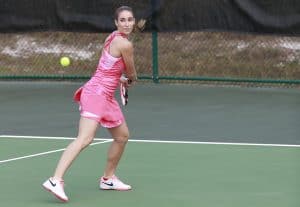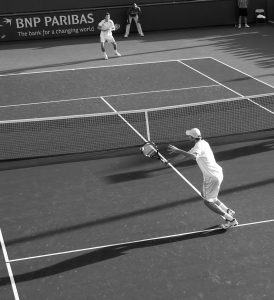The Elements of a Tennis Backhand
The backhand is a shot in tennis hit with your non-dominant hand on the non-dominant side of your body. To learn how to hit a backhand in tennis you must learn the elements that make up the backhand. The elements are footwork, ready position, court position, the swing, and recovery after the shot.
Unlike a typical forehand, which is hit with one hand, a backhand can be hit with either one or two hands. Each element is different for a one handed vs a two handed backhand. A beginner should start with two hands until they gain enough control, comfort, and power to switch to a one handed backhand. When making the switch, some of the elements will need to be adjusted as well.
Just like all the shots in tennis, you will have to learn to combine all of the elements of the backhand in order to hit a successful backhand. You will begin in the ready position, using your footwork to get there. Continuing to use great footwork will get you to the correct court position next. You are now ready to use your swing to hit the ball, also done with precise footwork. From this point your footwork will carry you through your recovery after the shot. Can you see the common theme?
One Handed Vs Two Handed Backhand
The benefits of a one handed backhand are more reach and a greater shot selection. Using two hands to hit a backhand will limit the racket to a closer proximity to the body. One hand allows you to reach further. One hand also allows you to use either a flat, topspin, or slice shot. Your limited swing motion with two hands makes a backhanded slice difficult. A slightly different set of elements to set up a one handed slice vs a two handed shot makes for a more difficult transition. Using a one handed backhand can also gain you more power. Your shoulder and hips will be rotating more, which will gain you an explosion of power. It should be noted that this power only is achieved with training. At the beginning, using one hand will definitely feel like your power is very inconsistent and mostly dulled. You might see an occasional explosion of power, and that is what we are striving for with a one handed backhand.
So why is the two handed backhand significantly more popular than the one handed? First, it’s the first one you learn. As a beginner, it’s difficult enough to hit a backhand. The second hand allows for more control, stability, and consistent power than a two handed backhand. It also gets you in the ready position earlier. When you are learning how to play tennis, repetition is the mother of learning. Changing from a one handed to a two handed backhand means learning new habits for all of the elements. This takes time and effort that can take away from other training. This is why most players stick with the two handed backhand they initially learn.

How to Hit a Two Handed Backhand
The backhand swing is the most discussed and the most important element to learning how to hit a proper two handed backhand. There are four parts to the swing: the grip, the backswing, the point of contact, and the follow through.

How to Grip the Racket for a Two Handed Backhand
It will be difficult to fully learn how to hit a tennis backhand without first knowing the grip you need. To achieve a consistent backhand grip begin with the heel of your dominant hand on the octagonal plane in line with the side of your racket head facing skyward. This is plane 1. Each plane to the right (when looking from the butt end of the racket) will be designated with the next corresponding number. The base knuckle of your index finger should be on plane 2. Your non-dominant hand should be on the grip above the dominant hand, holding the racket as though to hit a forehand. Using the semi western forehand grip for your non-dominant hand should give you a comfortable grip. Place the heel of your non-dominant hand on plane 7 and the base knuckle of your index finger on plane 6. It may be necessary to adjust for control, comfort, and power.
The Backswing
The backswing is where you will load for your backhand shot. As you turn your body, bring your racket head back toward the back of the court. Unlike the forehand, limit the loop in your backhand to simplify it. When you bring it back, lower it slightly to below the plane of the ball. When all the way back, the butt of the racket should be pointed toward the ball. Your non-dominant hand should be slightly lower than your dominant hand.
The Point of Contact
The point the racket hits the ball is called the point of contact. It should be hit in front of you, a few inches closer to the net than you are. If you hit the ball at your body or behind it, this will limit your angles and shot selections. You will lose your power as well. Your racket should be travelling forward and up at the same time. Your racket head should never open up. It should remain perpendicular to the court or pointed slightly down.
The Follow Through
The follow through is your swing after you hit the ball. It will be a continued version of your swing. If your racket started lower than the ball, then it should finish higher than the ball. Continue your swing path without letting go with either hand. Your racket should finish about shoulder high, with your non-dominant arm giving yourself a hug. Your non-dominant hand should finish at your dominant shoulder.
If you shorten your follow through your are likely to lose power on your shot. If you lengthen your follow through your shots may become erratic.

How to Hit a One Handed Backhand
The swing is the most talked about and the most important element to learning how to hit a proper one handed backhand. There are four parts to the swing: the grip, the backswing, the point of contact, and the follow through.

How to Grip the Racket For a One Handed Backhand
Learning how to hit the tennis ball with your one handed backhand means learning a new grip. The grip for a one handed backhand has the base knuckle of your index finger on position 1 of the grip. That’s the octagonal plane in line with the side of your racket head that is facing the sky. The heel of your hand will be one plane to the left (for a right handed player), which is plane 8. Your non-dominant hand will be on the high point of the racket, or on the bottom of the throat. It is there for stability and positioning at this point.
The Backswing
The backswing for a one handed backhand varies slightly from a two handed backhand in that the butt will be pointed slightly toward the backhand side net post instead of at the ball. You will still have two hands on the racket at this point. You will be rotating more with a one handed backhand so you must reach further back. Your racket head will slightly higher than with the two handed backhand. This will allow you to switch easily from a topspin or flat shot to a slice.
The Point of Contact
As you begin swinging the racket forward, you will release the racket from your non-dominant hand. When you strike the ball, your hips and shoulders should be rotating in full force. Your racket head will be perpendicular to the ground or pointed slightly toward the ground. The ball should be a few inches in front of you. The further back you hit the ball, the more you limit your opportunities for success.
The Follow Through
As you strike the ball you will opening up your arms as if to give the whole world a big hug. Your dominant arm will be stretched out fully at the finish. You will look like your an umpire who gave the safe sign to a close play at first base. Your legs should be stretched out to make you tall. You may even want to adopt a bit of a hop at the end of your shot. This could get you into position for your next shot and provide a bit of extra power as well.

Footwork of a Backhand
Your footwork will be a part of every shot you make in tennis. You must maintain balance while awaiting the shot and when arriving to the shot. After an explosion of energy and transfer of balance, you will regain control of yourself and your feet using footwork to recover for the next shot.
When preparing for a backhand, you want to be in the ready position. Position and footwork are key to learning how to hit the best tennis backhand you can hit. We will discuss footwork first because you will need it to get into the ready position. You will also need footwork while you are in the ready position.
To get into the ready position, get on the balls of your feet and begin to bounce up and down without ever leaving the ground more than an inch or so and without touching your heel to the ground. While keeping your feet pointed toward the other side of the net, shuffle laterally toward the center of the court.
Begin by stepping with the foot closest to the court’s center and pushing off with the opposite foot. Avoid crossing your feet, as you will lose court coverage and positioning. It is the first step in learning how to hit an effective and consistent forehand tennis shot.
When you arrive at your position the ball will be on your backhand side. As you arrive at the ball you will plant with your non-dominant foot, and step forward with your opposite foot as you hit the ball. As you hit the ball and step into it, bring your back foot forward and finish with your feet squared up to the net. You should be on the balls of your toes, shuffling slightly toward the middle of the court in order to gain more court coverage. This is when you head for the ready position.
Ready Position
To hit a tennis backhand you must get yourself to that ready position. When near the center of the court and in the most optimal position, continue bouncing slightly using your toes. This will allow you to be ready to explode from your position to where you need to be after the opponent hits their shot. Have your racket out in front of you prepared as if you are going to hit a volley. The face should be about neck or head high, without being uncomfortable or impeding your vision.
The dominant hand should be holding the grip with their preferred forehand grip. It may be more comfortable to use a continental grip here and switch to a forehand or backhand grip when necessary, but, I prefer waiting with a forehand grip. This allows me to know I’m ready for the forehand and only have to adjust for the backhand. Because my non-dominant hand will be on the grip for a backhand anyway, it’s easy for me to use it to help change my grip to a backhand.
The non-dominant hand will be higher up on the racket, on the throat or high part of the grip. It is there for support and is ready to guide or assist the dominant hand.
Your shoulders should be square to the net, with your eyes on the other player. Watch his movement and swing, and you will likely get an idea where he is going to hit the ball. Be careful not to make an impulse decision on where the ball is going, as guessing wrong will lead to an easy winner for your opponent. Once you know where the ball is going, then you can head that direction.
Court Position for a Backhand
The court position you want to be in to hit a backhand is where your body is less than an arm length away from the ball. The ball will be on the non-dominant side of your body, called the backhand side. To reach this position, use the same footwork as described earlier, shuffling laterally and limiting crossing your feet.
Recovery
The recovery after your one backhand will prepare you for your next shot. After your shot is hit, use the footwork discussed previously to move toward your next position. Shuffling toward the center of the court is the best default by allowing for more options for you and closing the court for your opponent. Get there as fast as you can, without crossing your feet, and get into that ready position.
Good luck out there while using these techniques for learning how to hit a backhand in tennis!

